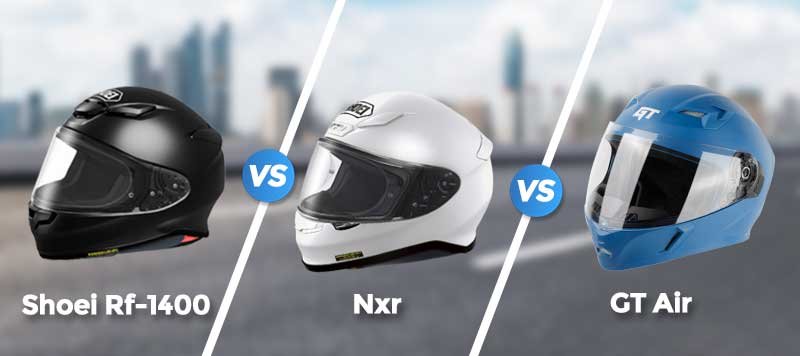
How are you supposed to choose the right motorcycle helmet? You could spend hours reading reviews and comparing models, but none of that will matter if you don’t know how to compare and contrast two different helmets in the first place. Fortunately, we’ve done this already with our Shoei RF-1400 vs NXR comparison. We’ll share what we learned after spending time with these two helmet models, so you can make an informed decision without having to spend hours reading reviews yourself. Keep reading to learn more!
No products found.
No products found.
Introduction
The Shoei RF-1400 is a pretty new helmet, which was released in 2013. It is basically a replacement for one of Shoeis’ most popular helmets from 2012 and before, namely their RX-Q. The biggest difference between these two helmets is that Shoei has tried to make their latest model slightly more aerodynamic than its predecessor. They’ve done so by incorporating different vents that incorporate drag reducing features such as spoilers on some of them. These changes should make for a more comfortable riding experience, but also make it easier to maintain your speed on longer journeys with less fatigue and effort on your part. But enough about that, let’s get right into how you can decide which of these two helmets might be best for you!
What’s the same?
The similar helmets at first glance seem to be pretty evenly matched. In fact, I can’t really find much of a difference in either one. Both have strong build quality and are priced very close to each other with both coming in at around $500. The biggest difference is that the Shoei RF-1400 has a larger face shield, at 3.5 compared to 3 on the Nolan helmet and it is also slightly lighter than its competitor. However, while most reviewers say they’re equal, Nolan wins more praise for overall comfort and better wind noise reduction which are two things many riders look for when considering a new helmet.
Differences – Comfort
This area is huge when it comes to evaluating a new helmet. All that weight and padding adds up, especially if you’re riding for long periods of time. You want to be as comfortable as possible with your helmet or you just won’t wear it. Comfort seems to be where both these helmets differ most noticeably. The NXR fits more snugly, and feels lighter when you wear it – though neither is really lighter than average. The RF-1300 on the other hand feels heavier (though its not), with a noticeable amount of wind noise at highway speeds, despite good aerodynamics.
Differences – Airflow
The Rf-1400 has one small vent on each side and a chin vent, while The NXR has two vents on each side and two separate chin vents. Venting is obviously very important, especially if you ride in hot weather. The amount of air flow is dependent on how many ports there are in your helmet; more is better because it allows more air to circulate around your head while you ride. Both helmets feature internal channels designed to channel warm air out of the top and cool air into it from under your chin to help keep you cool inside. They both also include breath deflectors that prevent fogging up of your visor when it’s cold outside but don’t block any ventilation ports or restrict airflow.
Conclusion
The NXR is a great helmet, and if you’re looking for a solid modular that also gives you some extra protection on your face, chin, and neck; it’s hard to go wrong with it. The Aeroclassic is also one of our favorites thanks to its plush interior and Snell certification. But if you want more coverage around your ears and back of your head at a lower price point, then check out our Shoei RF-1400 Review. It falls in between both helmets above when it comes to price range so there’s something for everyone.
Recent Posts
If you are looking to buy a new bike, then you should consider buying one of the many motorcycles that are out there on the market. One of the things that people are wondering about when they are...
Riding motorcycles in the rain can be intimidating, but it doesn’t have to be if you follow these easy tips. Here are some great ideas that you can use to help make your next ride in the rain safe...